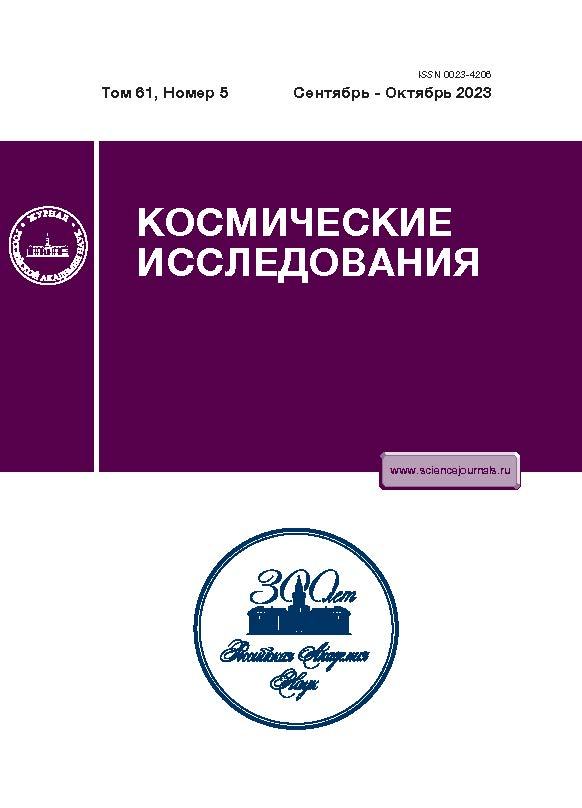Propellant Influence on Electromagnetic Environment Generated by Stationary Plasma Thrusters
- Authors: Plokhikh A.P.1, Vazhenin N.A.1, Merkurev D.V.1
-
Affiliations:
- Research Institute of Applied Mechanics and Electrodynamics of the Moscow Aviation Institute, 125080, Moscow, Russia
- Issue: Vol 61, No 5 (2023)
- Pages: 393-399
- Section: Articles
- URL: https://ruspoj.com/0023-4206/article/view/672612
- DOI: https://doi.org/10.31857/S0023420623700140
- EDN: https://elibrary.ru/HJLCFG
- ID: 672612
Cite item
Abstract
Possible aspects of violation of the functional safety of spacecraft in terms of electromagnetic compatibility with electric rocket thrusters in their work on alternative working substances are considered. The procedure of experimental determination of spectral–time characteristics of own electromagnetic radiation of laboratory model of stationary plasma thruster SPT-70 developed by the Research Institute of Applied Mechanics and Electrodynamics of the Moscow Aviation Institute is described. Measurements of noise emissions were carried out on a vacuum installation with a “radiotransparent” compartment and a shielded echo-free camera in the frequency range of 1–12 GHz for typical discharge capacities (600, 800, and 1000 W), vertical and horizontal polarization, and various working substances used (krypton and xenon). The conducted studies have allowed obtaining new comparative results of the assessment of spectral characteristics of SPT-70 radiation for standard modes and prospective working bodies within the orthogonal polarization bases. The new results should include information about the radiation characteristics of SPT-70 in the time area. It is shown that the transition from xenon to krypton retains the pulsed nature of the radiation of a stationary plasma thruster, leading not only to an increase in the amplitude of pulses, but also to an increase in the frequency of repetition of “bursts” and an increase in their duration, which requires additional measures to ensure electromagnetic compatibility in order to preserve the functional safety of the spacecraft.
About the authors
A. P. Plokhikh
Research Institute of Applied Mechanics and Electrodynamics of the Moscow Aviation Institute, 125080, Moscow, Russia
Email: riame@mai.ru
Россия, Москва
N. A. Vazhenin
Research Institute of Applied Mechanics and Electrodynamics of the Moscow Aviation Institute, 125080, Moscow, Russia
Email: riame@mai.ru
Россия, Москва
D. V. Merkurev
Research Institute of Applied Mechanics and Electrodynamics of the Moscow Aviation Institute, 125080, Moscow, Russia
Author for correspondence.
Email: riame@mai.ru
Россия, Москва
References
- Smith D.J., Simpson K.G.L. Functional Safety: A Straightforward Guide to IEC61508 and Related Standards. 1st ed. L.: Butterworth-Heinemann, 2001. 263 p.
- Smith D.J., Simpson K.G.L. The Safety Critical Systems Handbook: A Straightforward Guide to Functional Safety: IEC 61508 (2010 Edition), IEC 61511 (2016 Edition) and Related Guidance. 5th ed. L.: Butterworth-Heinemann, 2020. 360 p.
- Fortescue P., Swinerd G., Stark J. Spacecraft Systems Engineering. 4th ed. John Wiley and Sons Limited, 2011. 728 p.
- Nikitina V.F., Smirnova N.N., Smirnova M.N. et al. On-board electronic devices safety subject to high frequency electromagnetic radiation effects // Acta Astronautica. 2017. V. 135. P. 181–186. https://doi.org/10.1016/j.actaastro.2016.09.012
- Ахметжанов Р.В., Богатый А.В., Дьяконов Г.А. и др. Электрические ракетные двигатели нового поколения для малых космических аппаратов // Изв. Российской акад. наук. Энергетика. 2019. № 3. С. 3–13. https://doi.org/10.1134/S0002331019030038
- Kuge J., Bodin P., Persson S., Rathsman P. Accommodating electric propulsion on SMART-1 // Acta Astronautica. 2004. V. 55. Iss. 2. P. 121–130. https://doi.org/10.1016/j.actaastro.2004.04.003
- Krejcia D., Seiferta B., Scharlemann C. Endurance testing of a pulsed plasma thruster for nanosatellites // Acta Astronautica. 2013. V. 91. P. 187–193. https://doi.org/10.1016/j.actaastro.2013.06.012
- Yu Qin, Kan Xie, Ning Guo, Zun Zhang et al. The analysis of high amplitude of potential oscillations near the hollow cathode of ion thruster // Acta Astronautica. 2017. V. 134. P. 265–277. https://doi.org/10.1016/j.actaastro.2017.02.012
- Shuai Cao, Xuan Wang, Junxue Ren et al. Performance and plume evolutions during the lifetime test of a Hall-effect thruster // Acta Astronautica. 2020. V. 170. P. 509–520. https://doi.org/10.1016/j.actaastro.2019.12.036
- Pelton J.N., Madry S. Handbook of Small Satellites: Technology, Design, Manufacture, Applications, Economics and Regulation. Springer, 2020. 1702 p. https://doi.org/10.1007/978-3-030-36308-6
- Kim V., Zakharchenko V., Merkurev D. et al. Influence of Xenon and Krypton Flow Rates through the Acceleration Channel of Morozov’s Stationary Plasma Thruster on the Thrust Efficiency // Plasma Physical Reports. 2019. V. 45. Iss. 1. P. 11–20. https://doi.org/10.1134/S1063780X19010082
- Kim V., Merkurev D., Shilov E. et al. Study of the low-power krypton-operated stationary plasma thruster plume // IOP Conf. Series: Materials Science and Engineering. V. 927. 13th Intern. Conf. Applied Mathematics and Mechanics in the Aerospace Industry (AMM-AI’2020). 6–13 Sept. 2020, Alushta, Russia. 2020. Art. ID. 012053. https://doi.org/10.1088/1757-899X/927/1/012053
- Плохих А.П., Важенин Н.А., Попов Г.А. Анализ влияния электромагнитного излучения стационарных плазменных двигателей на помехоустойчивость канала связи “Земля – космический аппарат” // Косм. исслед. 2019. Т. 57. № 5. С. 339–346. (Cosmic Research. 2019. V. 57. Iss. 5. P. 317–324.)https://doi.org/10.1134/S0023420619050078
- Beiting E., Pollard J., Khayms V. et al. Electromagnetic Emissions to 60 GHz from a BPT4000 EDM Hall Thruster // Intern. Electric Propulsion Conf. Toulouse France. 17–21 March 2003. Art. ID. IEPC-03-129. P. 17–21.
- Beiting E., Eapen X., Pollard J. et al. Electromagnetic Emissions from PPS®1350 Hall Thruster // 31st Intern. Electric Propulsion Conf. 20–24 Sept. 2009, Ann Arbor, USA. Art. ID. IEPC-2009-071. 13 p.
- Ciarallia S., Colettib M., Gabriela S.B. Results of the qualification test campaign of a Pulsed Plasma Thruster for Cubesat Propulsion (PPTCUP) // Acta Astronautica. 2016. V. 121. P. 314–322. https://doi.org/10.1016/j.actaastro.2015.08.016
- Плохих А.П., Важенин Н.А., Попов Г.А., Шилов С.О. Спектральные характеристики собственного излучения электрических ракетных двигателей с замкнутым дрейфом электронов в радиодиапазоне для различных рабочих тел // Косм. исслед. 2022. Т. 60. № 5. С. 396–403. https://doi.org/10.31857/S0023420622050065
Supplementary files

















